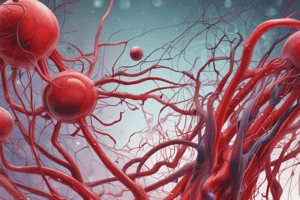Podcast
Questions and Answers
What is the product of the liver that has 5 glycosylated loops (kringles) bound to a lysine residue?
What is the product of the liver that has 5 glycosylated loops (kringles) bound to a lysine residue?
- Plasmin
- Fibrin clot
- Plasminogen (correct)
- Fibrinogen
What is the primary inhibitor of free plasmin?
What is the primary inhibitor of free plasmin?
- Streptokinase
- Plasminogen
- Alpha-1 Antiplasmin (correct)
- TAFI
What is the last phase of normal clotting process when the patient tries to have wound or tissue injury?
What is the last phase of normal clotting process when the patient tries to have wound or tissue injury?
- Clot dissolution (correct)
- Thrombus formation
- Fibrin clot formation
- Fibrinolysis
What is the normal value of euglobulin clot lysis?
What is the normal value of euglobulin clot lysis?
What is the role of factor 13 in the clotting process?
What is the role of factor 13 in the clotting process?
What is the result of excessive digestion of fibrin by plasmin?
What is the result of excessive digestion of fibrin by plasmin?
What is the function of TAFI?
What is the function of TAFI?
What is the effect of the absence of activators in plasminogen?
What is the effect of the absence of activators in plasminogen?
What is the principle of D-Dimer test?
What is the principle of D-Dimer test?
What is the role of plasmin in the clotting process?
What is the role of plasmin in the clotting process?
What is the result of Plasminogen chromogenic substrate Assay?
What is the result of Plasminogen chromogenic substrate Assay?
What is the result of too much activation of plasminogen?
What is the result of too much activation of plasminogen?
What is the activator used in Plasminogen chromogenic substrate Assay?
What is the activator used in Plasminogen chromogenic substrate Assay?
What is the role of TPA (tissue plasminogen activators) in the clotting process?
What is the role of TPA (tissue plasminogen activators) in the clotting process?
What is the half-life of TPA?
What is the half-life of TPA?
What is the primary function of PAI-1?
What is the primary function of PAI-1?
What is the normal value of TPA in the blood?
What is the normal value of TPA in the blood?
What is the result of excessive plasminogen activation in cancer cells?
What is the result of excessive plasminogen activation in cancer cells?
What is the main difference between primary and secondary fibrinolysis?
What is the main difference between primary and secondary fibrinolysis?
What is the function of thrombin-thrombomodulin in fibrinolysis?
What is the function of thrombin-thrombomodulin in fibrinolysis?
What is the result of a deficiency in PAI-1?
What is the result of a deficiency in PAI-1?
What is the normal whole blood clotting time?
What is the normal whole blood clotting time?
Flashcards are hidden until you start studying
Study Notes
Tissue Plasminogen Activators (TPA)
- Has 2 glycosylated loops
- Half-life: 3 minutes
- Normal value: 5 mg/dL
- Produced by endothelial cells
- Binds to plasminogen activator inhibitor (PAI-1)
Urokinase Plasminogen Activator (UPA)
- Produced by urinary epithelial cells, monocytes, and macrophages
- Half-life: 7-15 minutes
- Normal value: 2-4 mg/mL
- Major activator produced by kidney
Fibrinolysis Inhibitors
- Alpha-2 antiplasmin: primary inhibitor of free plasmin
- Competes with plasminogen for lysine residue binding site
- Binds and inactivates plasmin
- Alpha-2 macroglobulin
- Thrombospondin
- Plasminogen activator inhibitor 1 (PAI-1)
- Principal inhibitor
- Allows binding of plasminogen
- Main activity: inhibits plasminogen activators (TPA and UPA)
- Produced by endothelial cells, megakaryocytes, smooth muscle cells, fibroblasts, monocytes, adipocytes, and hepatocytes
- PAI-2
Fibrinogen and Fibrin
- Fibrinogen: has 2 D-domains and 1 E-domain
- Fibrin: represents the original structure of fibrinogen
- Fibrin monomer: resulted from the action of thrombin on fibrinogen
- D-Dimer: fragments of fibrin that are produced during fibrinolysis
Tests for Fibrinolysis
- Whole blood clotting time
- Normal value: lysis more than 48 hours
- Abnormal: lysis less than 48 hours
- Euglobulin clot lysis
- Euglobulin: portion of plasma with fibrinogen, plasminogen, and plasmin activators
- Procedure: plasma + HAc (pptn) → dissolve in buffer + thrombin (to digest)
- Normal value: lysis more than 2 hours
- Abnormal: lysis less than 2 hours
- Protamine sulfate test for fibrin monomer
- Ethanol gelation test for fibrin monomer
- D-Dimer test
- Specific for DIC
- Positive for D-dimer means positive in DIC
- Principle: immunoassay (test for D-dimer)
- Plasminogen chromogenic substrate assay
- Principle: measures plasminogen activity
- Result: intensity of yellow color directly proportional to plasminogen concentration
- Normal value: 5-13.5 mg/dL
Studying That Suits You
Use AI to generate personalized quizzes and flashcards to suit your learning preferences.




